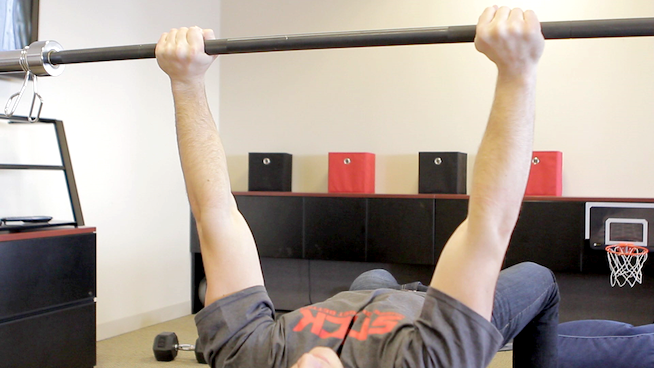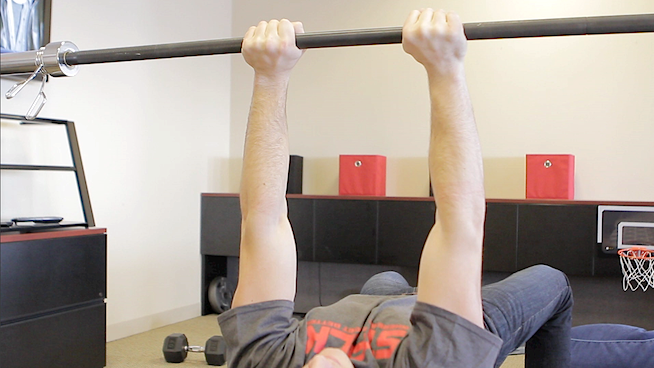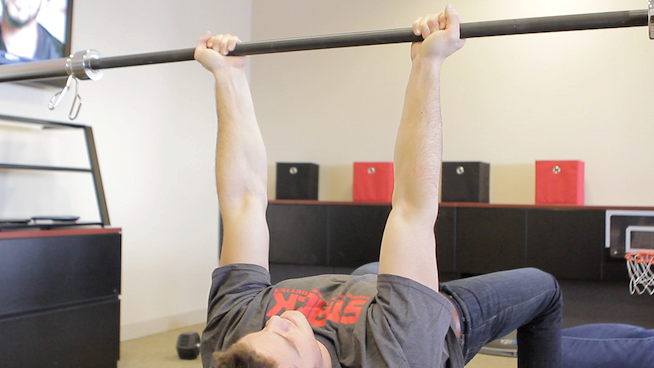Bench Press Grip Guide: How Hand Placement Changes the Exercise
![]()
When you’re working out in the weight room, small changes can make a big difference. An inch here or there might seem insignificant, but being aware of minor alterations and their effects can help you get more out of your workouts and improve your performance.
With that in mind, we examine one of the most commonly overlooked parts of weightlifting— the grip. Many people simply grab the iron and crank out their reps, using a grip that feels natural but giving no thought to how it might affect the exercise. But letting it rip before knowing how to grip is a rookie mistake. With tons of exercises, minor changes to how you hold the bar can make a big difference in your results.
With the help of Tony Bonvechio, strength coach at Cressey Performance, and J.L. Holdsworth, professional power lifter and founder of The Spot Athletics, STACK takes a look at several grips athletes can use for the world’s most popular exercise—the Bench Press. Mixing up your grips and knowing when to use one over another can give you the upper hand on your competition.
Note: hand positions are general guidelines. Athletes with particularly long or short arms may need to adjust their hand positions to suit their bodies.
Traditional Grip

Position: hands at shoulder-width or a couples of inches wider
The traditional grip is the most common grip used for Benching, and it offers a nice balance of comfort and control. For most people, the traditional grip allows them to move the most weight.
“The traditional grip provides a good combination of speed off the chest and range of motion,” Bonvechio says. It also engages the most well-rounded muscle activity, making it a good choice if you’re trying to build general upper-body strength.
Nearly every athlete has benched with a traditional grip—and for good reason. It’s comfortable, it allows for a good range of motion, it’s relatively safe and it translates fairly well to athletic competition. However, if you’re looking to target particular muscle groups more than others, the traditional grip might not be the way to go.
Wide Grip

Position: Hands 4 inches outside shoulder-width or wider
The wide grip is the most movement-efficient Bench Press grip to use in terms of bar path, meaning it requires the least amount of bar movement to complete a rep. Although that might sound enticing to anyone looking to press the most weight possible, the grip can severely limit bar speed.
“The decreased range of motion may allow for more weight, but many people struggle to build bar speed off their chest with this grip,” Bonvechio says. Most athletes (except for competitive powerlifters) find that the amount of weight they can press with a wide grip is no greater than what they can press with a traditional grip.
Although some studies have shown that a wide grip more effectively activates the lower part of the pectoralis major (known as the sternocostal head), the wide grip also places a lot more stress on the shoulders than both the medium and close grips. One study found that the Wide Grip Bench Press places 50 percent more torque on the shoulders than a Bench Press done with a narrower grip.
Also, the wide grip might not translate particularly well to athletic competition. In most sports, any pressing is usually done with the hands shoulder-width apart or narrower. Limited range of motion is another reason the wide grip might not translate well to many athletic movements.
RELATED: 10 Bench Press Variations for a Bigger and Stronger Chest
Close Grip

Position: Hands inside shoulder-width, 8-12 inches apart
The close grip offers the most range of motion of any Bench Press grip. The closer your hands are together, the further you have to move the bar to lock it out and complete a rep. This means you probably won’t be setting any personal records using a close grip, but a host of other benefits makes up for it.
Studies have shown that the close grip provides greater activation of the triceps brachii or “Tris.”
RELATED: How Your Triceps Can Help You Build a Bigger Bench Press
“The triceps are significantly more dominant in a Close Grip Bench Press than the other variations. The increased elbow flexion puts the triceps in a position where they’ve got to do a lot more work than a traditional Bench Press,” Holdsworth says. That means the close grip can help you get those horseshoe triceps you’ve always dreamed of. Not only that, a close grip has also been shown to provide greater activation of the upper part of the pectorals major (known as the clavicular head). Finally, a close grip places much less stress on the shoulders than a wide grip, possibly making it safer.
However, Bonvechio warns that some beginners place their hands too close together, which puts harmful stress on the wrists.
“Some people go way too narrow with their close grip, to the point that their thumbs are almost touching. This will cause your elbows to flare out, and you’ll be essentially supporting all the weight on your wrists,” Bonvechio says. To combat flaring elbows on the Close Grip Bench, Bonvechio gives the cue of “crushing the bar in your hands and rolling your knuckles forward as you bring the bar down.” This will help you keep your elbows under the bar and ensure a neutral wrist angle.
The close grip might be the best grip in terms of translating to athletics. It offers the greatest range of motion and it works on pressing from a narrow hand position, a movement common to many sports. Think of the way an offensive lineman delivers a punch to a defender. Ideally his hands are close together with his elbows in.
Reverse Grip

Position: underhand or “supinated” grip, hands slightly wider than shoulder-width apart
The Reverse Grip Bench Press is a controversial exercise. Although some research suggests that a reverse grip more deeply activates the biceps brachia (or “Bis”), some experts are not huge fans. “If there’s a good reason to use the reverse grip, I haven’t found it yet,” Bonvechio says.
One of the biggest concerns with the reverse grip is safety. It requires holding the bar in a somewhat precarious position, making the bar susceptible to slipping from your hands. To avoid this, many lifters roll their hands back, putting a ton of harmful pressure on their wrists.
If you want to give the reverse grip a shot, do so only after you are well-versed in the traditional grip Bench Press. Always use a spotter. “The Reverse Grip Bench Press is a movement that I don’t recommend for beginners. You need to master the regular Bench Press before trying this version,” Holdsworth says.
RELATED: Build a Bigger Upper Chest with These Exercises
Suicide Grip

Position: thumbs are placed over the bar instead of under, also known as a “false grip”
The aptly named “suicide grip” refers to a grip where the thumbs are placed over the bar instead of under it. Some lifters believe this grip offers benefits like increased triceps activity and reduced shoulder stress, but any potential benefits are strongly overshadowed by the dangers. By moving your thumbs to over the bar, you essentially remove the one barrier that keeps it from rolling out of your hands.
“While I do know some extremely elite level lifters who use the suicide grip, I do not recommend it,” Holdsworth says. “When I was young, I used to use this grip, but after dropping 315 on my chest, I never used it again. The bar just slipped out of my hands. If it had landed on my neck, it may indeed have been suicide. I’ve never used it since. Simply put, it isn’t a good idea.”
“Some people swear it takes stress off their shoulders, but it’s pretty risky,” Bonvechio says.
Don’t use the suicide grip. The danger is too great to ignore.
RECOMMENDED FOR YOU
Bench Press Grip Guide: How Hand Placement Changes the Exercise
![]()
When you’re working out in the weight room, small changes can make a big difference. An inch here or there might seem insignificant, but being aware of minor alterations and their effects can help you get more out of your workouts and improve your performance.
With that in mind, we examine one of the most commonly overlooked parts of weightlifting— the grip. Many people simply grab the iron and crank out their reps, using a grip that feels natural but giving no thought to how it might affect the exercise. But letting it rip before knowing how to grip is a rookie mistake. With tons of exercises, minor changes to how you hold the bar can make a big difference in your results.
With the help of Tony Bonvechio, strength coach at Cressey Performance, and J.L. Holdsworth, professional power lifter and founder of The Spot Athletics, STACK takes a look at several grips athletes can use for the world’s most popular exercise—the Bench Press. Mixing up your grips and knowing when to use one over another can give you the upper hand on your competition.
Note: hand positions are general guidelines. Athletes with particularly long or short arms may need to adjust their hand positions to suit their bodies.
Traditional Grip

Position: hands at shoulder-width or a couples of inches wider
The traditional grip is the most common grip used for Benching, and it offers a nice balance of comfort and control. For most people, the traditional grip allows them to move the most weight.
“The traditional grip provides a good combination of speed off the chest and range of motion,” Bonvechio says. It also engages the most well-rounded muscle activity, making it a good choice if you’re trying to build general upper-body strength.
Nearly every athlete has benched with a traditional grip—and for good reason. It’s comfortable, it allows for a good range of motion, it’s relatively safe and it translates fairly well to athletic competition. However, if you’re looking to target particular muscle groups more than others, the traditional grip might not be the way to go.
Wide Grip

Position: Hands 4 inches outside shoulder-width or wider
The wide grip is the most movement-efficient Bench Press grip to use in terms of bar path, meaning it requires the least amount of bar movement to complete a rep. Although that might sound enticing to anyone looking to press the most weight possible, the grip can severely limit bar speed.
“The decreased range of motion may allow for more weight, but many people struggle to build bar speed off their chest with this grip,” Bonvechio says. Most athletes (except for competitive powerlifters) find that the amount of weight they can press with a wide grip is no greater than what they can press with a traditional grip.
Although some studies have shown that a wide grip more effectively activates the lower part of the pectoralis major (known as the sternocostal head), the wide grip also places a lot more stress on the shoulders than both the medium and close grips. One study found that the Wide Grip Bench Press places 50 percent more torque on the shoulders than a Bench Press done with a narrower grip.
Also, the wide grip might not translate particularly well to athletic competition. In most sports, any pressing is usually done with the hands shoulder-width apart or narrower. Limited range of motion is another reason the wide grip might not translate well to many athletic movements.
RELATED: 10 Bench Press Variations for a Bigger and Stronger Chest
Close Grip

Position: Hands inside shoulder-width, 8-12 inches apart
The close grip offers the most range of motion of any Bench Press grip. The closer your hands are together, the further you have to move the bar to lock it out and complete a rep. This means you probably won’t be setting any personal records using a close grip, but a host of other benefits makes up for it.
Studies have shown that the close grip provides greater activation of the triceps brachii or “Tris.”
RELATED: How Your Triceps Can Help You Build a Bigger Bench Press
“The triceps are significantly more dominant in a Close Grip Bench Press than the other variations. The increased elbow flexion puts the triceps in a position where they’ve got to do a lot more work than a traditional Bench Press,” Holdsworth says. That means the close grip can help you get those horseshoe triceps you’ve always dreamed of. Not only that, a close grip has also been shown to provide greater activation of the upper part of the pectorals major (known as the clavicular head). Finally, a close grip places much less stress on the shoulders than a wide grip, possibly making it safer.
However, Bonvechio warns that some beginners place their hands too close together, which puts harmful stress on the wrists.
“Some people go way too narrow with their close grip, to the point that their thumbs are almost touching. This will cause your elbows to flare out, and you’ll be essentially supporting all the weight on your wrists,” Bonvechio says. To combat flaring elbows on the Close Grip Bench, Bonvechio gives the cue of “crushing the bar in your hands and rolling your knuckles forward as you bring the bar down.” This will help you keep your elbows under the bar and ensure a neutral wrist angle.
The close grip might be the best grip in terms of translating to athletics. It offers the greatest range of motion and it works on pressing from a narrow hand position, a movement common to many sports. Think of the way an offensive lineman delivers a punch to a defender. Ideally his hands are close together with his elbows in.
Reverse Grip

Position: underhand or “supinated” grip, hands slightly wider than shoulder-width apart
The Reverse Grip Bench Press is a controversial exercise. Although some research suggests that a reverse grip more deeply activates the biceps brachia (or “Bis”), some experts are not huge fans. “If there’s a good reason to use the reverse grip, I haven’t found it yet,” Bonvechio says.
One of the biggest concerns with the reverse grip is safety. It requires holding the bar in a somewhat precarious position, making the bar susceptible to slipping from your hands. To avoid this, many lifters roll their hands back, putting a ton of harmful pressure on their wrists.
If you want to give the reverse grip a shot, do so only after you are well-versed in the traditional grip Bench Press. Always use a spotter. “The Reverse Grip Bench Press is a movement that I don’t recommend for beginners. You need to master the regular Bench Press before trying this version,” Holdsworth says.
RELATED: Build a Bigger Upper Chest with These Exercises
Suicide Grip

Position: thumbs are placed over the bar instead of under, also known as a “false grip”
The aptly named “suicide grip” refers to a grip where the thumbs are placed over the bar instead of under it. Some lifters believe this grip offers benefits like increased triceps activity and reduced shoulder stress, but any potential benefits are strongly overshadowed by the dangers. By moving your thumbs to over the bar, you essentially remove the one barrier that keeps it from rolling out of your hands.
“While I do know some extremely elite level lifters who use the suicide grip, I do not recommend it,” Holdsworth says. “When I was young, I used to use this grip, but after dropping 315 on my chest, I never used it again. The bar just slipped out of my hands. If it had landed on my neck, it may indeed have been suicide. I’ve never used it since. Simply put, it isn’t a good idea.”
“Some people swear it takes stress off their shoulders, but it’s pretty risky,” Bonvechio says.
Don’t use the suicide grip. The danger is too great to ignore.










